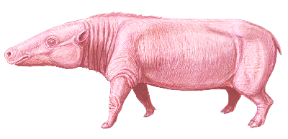Jaggermeryx
Anthracothere commemorates a rock star's lips
|
|
—EUGENE M. MCCARTHY
June 28, 2016 — It doesn’t matter that it didn’t shake, rattle and roll like Mick Jagger. Having large lips was enough for scientists to name an extinct creature that lived in Africa 19 million years ago Jaggermeryx naiad.
The name translates to “Jagger’s water nymph,” said study co-author Ellen Miller of Wake Forest University. The animal's fossilized jaw bone fragments suggest it was roughly the size of a small deer, resembling a cross between a slender hippo and a long-legged pig. The researchers didn’t say whether the animal’s hind quarters would allow it to strut across a stage while waving a microphone, but speculated whether such an ability might have contributed to this ancient creature's extinction.
Researchers uncovered the fossils amid the sand dunes and eroded rock of a remote site in the Egyptian desert. There were no tambourines or platform shoes found near the fossils. Geological data suggest that millions of years ago the site was a lush tropical delta crisscrossed by rivers and swampland.
Jaggermeryx is one of six different types of anthracotheres found at the site. Anthracotheres are a family of extinct hoofed animals (Anthracotheriidae). Distinguishing it from other members of this family was a series of tiny holes on either side of its jaw that held the nerves providing sensation to the chin and lower lip.
“The animal probably had a highly innervated muzzle with mobile and tactile lips, thus the Jagger reference,” said Duke University paleontologist and study co-author Gregg Gunnell.
“It may have used its sensitive snout to forage along river banks, scooping up plants with its lower teeth and large lips,” Miller said. It isn’t known whether Sir Mick has foraged in the same way.
The Jaggermeryx fossils now reside in collections at Duke, the Cairo Geological Museum and Cairo University. Also found were fossilized catfish, turtles, waterbirds and crocodile “coprolites” (fossilized poop).
“Some of my colleagues suggested naming the new species after Hollywood star Angelina Jolie, because she also has famous lips,” said Miller. “But for me it had to be Mick.” One can only suppose that this choice of epithet holds profound significance for the future of science.
So what's next on the paleontological platter? Perhaps Jimmydurantesaurus meganasalis? We can only wait and see.
(Adapted from materials obtained from the AAAS. Access original article >>)
Most shared on Macroevolution.net:
Human Origins: Are we hybrids?
On the Origins of New Forms of Life
Mammalian Hybrids
Cat-rabbit Hybrids: Fact or fiction?
Famous Biologists
Dog-cow Hybrids
Georges Cuvier: A Biography
Prothero: A Rebuttal
Branches of Biology
Dog-fox Hybrids

